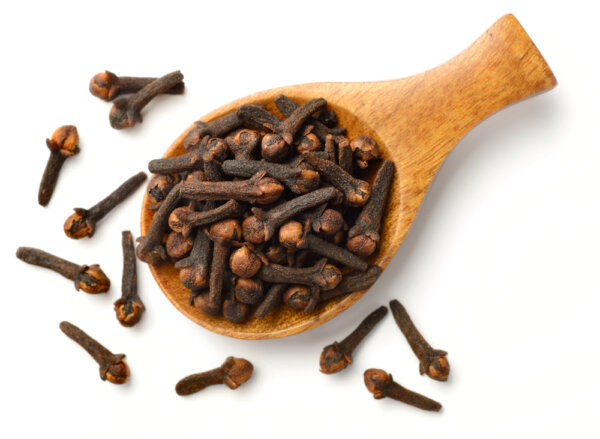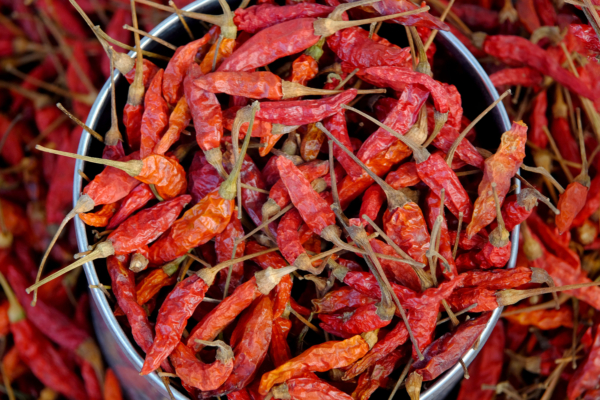At some point, everyone will experience pain—from a scraped knee to a herniated disc. Although our inclination may be to reach for an ibuprofen, nature offers us multiple ways to achieve natural pain relief. A wide variety of herbs have been used throughout the ages to help us when we are hurting. Let’s look at some herbs well-known for their pain-relieving effects.
Boswellia/Frankincense
Boswellia serrata is a tree native to Africa, India, and the Middle East, and is famous for producing the resin known as frankincense. With a long and distinguished history frankincense has been used for millennia in medicine, cosmetics, and religious rituals.
Boswellia is known for its anti-inflammatory properties and is one of the most cherished herbs in Ayurvedic medicine (the traditional medicine of India), where it’s used for a wide variety of ailments, from arthritis to asthma.

History
The ancient Egyptians used frankincense for beautification purposes, grinding the charred resin into a powder to use as eyeliner and for tattoos.
Frankincense was a prescription for throat infections, asthma, and to stop bleeding, according to the Egyptian Ebers Papyrus, written in approximately 1500 B.C.
In the tenth century A.D., Avicenna, the Iranian physician, philosopher, and scientist, prescribed frankincense to treat ulcers, fevers, and tumors.
Frankincense was mentioned in the Mingyi Bielu, a Chinese herbal medical text dating back to 500 A.D. In Chinese medicine, frankincense is known as ru xiang and is used to move blood and break up masses such as tumors. Research is now confirming frankincense’s anti-tumor effects and potential to treat cancer.
Throughout history, frankincense has been a highly valued commodity and has several mentions in both the Old and New Testaments of the Bible. Along with gold and myrrh, frankincense was one of the gifts brought by the wise men to the birth of Jesus.
Actions
Frankincense boosts the immune system and is a potent anti-inflammatory with antiseptic, astringent, disinfectant, diuretic, digestive, and expectorant properties.
The most common part of the Boswellia tree used medicinally is the resin or frankincense, but other parts, like the bark, are also used. Frankincense can also be steam-distilled into an essential oil, making it easier to use.
Studies
Frankincense is well-researched, and studies support its use for various types of pain.
In a 2022 randomized controlled trial, a formulation of frankincense (Boswellia) and turmeric extracts were combined in sesame oil to test their analgesic effects on exercise-induced pain. Two hundred thirty-two healthy participants with “moderate-to-severe exercise-induced acute musculoskeletal pain” were split into two groups. One received either a single dose of 1000 mg of the turmeric/frankincense formulation or a placebo. The intervention group “showed a significant reduction in pain intensity with 97.85% improvement” … compared with 2.46% in placebo” group. The researchers concluded that “exercise-induced acute musculoskeletal pain can be effectively relieved” by the turmeric/frankincense formulation in approximately three hours—demonstrating its powerful analgesic effects.
Another randomized controlled trial found that participants with osteoarthritis of the knee who received an extract of Boswellia serrata over 120 days had significantly reduced pain and stiffness compared to those receiving a placebo. In addition, the study noted their physical function was substantially improved.
Contraindications
- Because Boswellia/frankincense is a powerfully “moving” herb, it is not recommended for women during pregnancy and should be used with caution in those with digestive issues. Because of its moving nature, long-term use is not advised.
- When using any essential oil topically, dilute it in a carrier oil like coconut, almond, or jojoba to ensure it doesn’t irritate your skin.
- If you are considering taking frankincense internally, be sure you are using a 100 percent pure oil labeled for internal use, and do so under the guidance of a health professional.
Clove
Clove, or Syzygium aromaticum, is the flowering bud of the S. aromaticum tree—a tropical evergreen tree indigenous to Indonesia. Clove is a common spice used to flavor meats and baked goods and is popular in many holiday dishes. Clove has long been used to treat pain, especially toothaches.

History
In the Middle Ages, Europeans used cloves to preserve foods and to flavor and garnish dishes.
According to Encyclopedia Britannica, as far back as 200 B.C., envoys from Java to China in the Han Dynasty brought cloves to keep in their mouths during audiences with the emperor to freshen their breath.
Actions
Cloves are packed with antioxidants and have anti-inflammatory, antibacterial, antiviral, antifungal, and anti-cancer properties. One of the main bioactive compounds in clove is eugenol, which has many medicinal benefits, which include relieving pain. Eugenol has also been shown to inhibit platelet aggregation.
Due to their anesthetic and analgesic properties, cloves are used to numb and dull tooth pain.
Studies
Toothaches are highly unpleasant and something we all want to avoid whenever possible. Fortunately, modern studies validate the therapeutic use of cloves for tooth pain.
One study published in the British Journal of Oral and Maxillofacial Surgery found that a paste made with eugenol reduced pain, inflammation, and infection better than another analgesic tested. Participants who used the eugenol paste also had better wound healing than those who used the other treatment or the placebo.
A 2023 study tested eugenol and articaine (a local anesthetic used in dentistry) for pain relief after an emergency dental procedure called a pulpectomy—where the innermost tissue of the tooth is removed. One hundred patients were split into two groups after their pulpectomy procedures. One group was given eugenol and the other was given articaine—participants then evaluated their level of pain after one, three, and seven days. The study found that both treatments were highly effective on the first day, but that eugenol had a more powerful effect. The authors concluded that although both treatments worked well, eugenol was superior in its pain-relieving effects.
Contraindications
- Because of eugenol’s antiplatelet effects, people taking blood-thinning medications should not take cloves or use clove oil.
- Anyone having surgery should stop using cloves at least two weeks before their scheduled procedure to reduce the risk of bleeding.
- Because of their high eugenol content, clove can irritate digestive mucosa if taken in high doses. Those with gastritis and ulcers should not use cloves, which could aggravate their condition and increase pain.
Cayenne Peppers
Cayenne pepper, or Capsicum annum, not only gives you a boost of flavor but is also a potent pain reliever. Cayenne peppers contain capsaicin, responsible for their spicy flavor and medicinal benefits—including pain relief.
The capsaicin in cayenne peppers benefits the heart and circulatory system as it is a powerful stimulant and blood thinner. Capsaicin is also used to support weight loss and enhance the immune system.

History
Originally grown in Central and South America, cayenne peppers were used as far back as 7000 B.C. based on fossil feces and seeds found on cave floors in Mexico. Based on these samples, scientists believe cayenne peppers were first cultivated between 5200 and 3400 B.C., making them one of the world’s oldest cultivated plants.
Actions
Cayenne peppers are full of antioxidants, which explain their immune-boosting effects. Cayenne peppers also contain potent anti-inflammatory properties, helping them to relieve pain.
Studies
Studies abound demonstrating the power of cayenne peppers to combat pain from arthritis, nerve pain, muscle pain, headaches, and painful skin conditions like pruritis and psoriasis. The FDA has even approved an 8 percent capsaicin patch for “the management of neuropathic pain associated with postherpetic neuralgia.”
A study published in the British Journal of Anaesthesia found that a single, one-hour application of an 8 percent capsaicin patch provided effective pain relief for up to 12 weeks for patients with peripheral neuropathy.
A topical jelly containing capsaicin reduced pain before a migraine by 50 percent versus the Vaseline jelly that was used as a control. The pain was reduced by 50 percent in patients during a mild-to-moderate migraine attack, according to findings from a randomized-controlled trial published in the International Journal of Clinical Practice.
In a double-blind study, patients with chronic migraines found that capsaicin reduced pain by 50–80 percent compared to the placebo group.
Contraindications
- As with any food or herb used medicinally, some caution is required. Using cayenne topically or internally can cause adverse reactions in some people, including irritation, inflammation, and a burning sensation.
- The simplest way to introduce cayenne is to add the dried powder to foods and drinks—this allows you to incorporate it slowly and see how you feel.
- If you are on any medications, speak to a health care practitioner before taking cayenne, especially if you are taking blood thinners. Cayenne’s blood thinning properties can cause interactions with your medications or compound their effects.
- If you are using fresh peppers, be careful not to touch your eyes when handling them (ouch!).
Lavender
Lavender, or Lavandula angustifolia, has an enchanting aroma and is known for its calming effects on the nervous system and ability to help us relax and get a good, restful night’s sleep. Although it works wonderfully to bring us into a more relaxed state, lavender has other benefits, including wound healing, fighting inflammation, and relieving pain.
Lavender is used in cooking and medicine and has long been used by cultures around the globe as a perfume for its wonderful fragrance.

History
Ancient Egyptians used lavender in their embalming practices, and the Romans used lavender in their baths. The Greek physician Dioscorides wrote about the medical uses of lavender in his book De Materia Medica in 77 A.D.
According to one source, Queen Elizabeth I used lavender “as a perfume and in tea to treat migraines.”
Actions
Along with its analgesic and anti-inflammatory effects, lavender also exhibits antifungal, antimicrobial, antibacterial, and anti-parasitic, as well as neurologic actions.
Lavender is known to benefit depression, anxiety, and stress. It is a common remedy for headaches (especially those caused by tension and stress) and supports natural sleep—in addition to repelling insects, healing wounds, and treating pain.
Studies
Studies show lavender to be an effective pain reliever, especially when inhaled.
One randomized controlled trial investigated the effects of inhaled lavender aromatherapy on cancer patients before inserting a needle into an “implantable central venous port catheter” (a tube that goes into your body via your arm or chest and ends near your heart.) According to the study, the procedure commonly causes pain and anxiety.
One hundred twenty-three patients were split into three groups: one receiving lavender, one receiving eucalyptus, and the other a placebo. Participants inhaled three drops of essential oils for three minutes before the procedure. The placebo group had no intervention. The study found that the lavender group experienced significantly less anxiety than the control group.
Another study found that patients inhaling lavender had significantly reduced levels of pain and anxiety before a “post-surgical chest tube removal” procedure, which the study states “is associated with a significant pain and discomfort for patients.”
In a 2020 review of twenty studies (including human and animal studies), wounds treated with lavender essential oil healed more quickly, collagen production increased, and there was “enhanced activity of proteins involved in the tissue remodeling process.”
Contraindications
- If you are using lavender essential oil, dilute it in a carrier oil, as described above, as essential oils are very concentrated and can cause irritation to the skin when applied topically.
- Always consult with a health care practitioner before introducing herbs if you are on any medication or are pregnant.
- Women who are pregnant should avoid using lavender essential oil or any other herbal products during the first trimester of pregnancy when the baby is most susceptible to toxins and other substances that could be harmful.
Final Thoughts
A tremendous variety of herbs can offer natural pain relief, and the ones above are only a few examples that are inexpensive, easy to find, and simple to use. So the next time you are bothered by a headache, get a little overzealous at the gym or feel the aches and pains of getting older, relief may be as close as your garden or kitchen cabinet.



